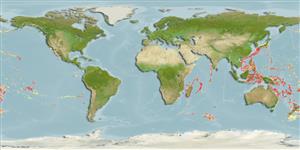Environment: milieu / climate zone / गहराई सीमा / distribution range
पारिस्थितिकी
समुद्री बाथीड़िमरसल; गहराई सीमा 250 - 650 m (Ref. 559). Deep-water
Indo-Pacific.
आकार / वज़न / Age
परिपक्व अवधि: Lm ? range ? - ? cm
Max length : 6.8 cm SL पुल्लिंग / अलिंग; (Ref. 1690)
पृष्ठीय रीढ़ (सम्पूर्ण) : 12; पृष्ठीय सौफट रेज़ (सम्पूर्ण) : 7; गुदा कांटा: 3; ऐनल सौफट रेज़: 5; जानवरों की रीड़ का जोड़: 26. Presence of very well developed flat spines on suborbital ridge; a number of extra spines on head, particularly on lachrymal bone and above orbits (Ref. 10482).
Body shape (shape guide): fusiform / normal.
Life cycle and mating behavior
परिपक्व अवधि | पुनरुत्पत्ति | मछलीऔ का अंडे देना | अंडे | Fecundity | लार्वा
Masuda, H., K. Amaoka, C. Araga, T. Uyeno and T. Yoshino, 1984. The fishes of the Japanese Archipelago. Vol. 1. Tokai University Press, Tokyo, Japan. 437 p. (text). (Ref. 559)
IUCN Red List Status (Ref. 130435: Version 2025-1)
Human uses
मात्स्यिकी: bycatch
साधन
Special reports
Download XML
इंटरनेट स्रोत
Estimates based on models
Preferred temperature (संदर्भ
123201): 2.3 - 14.4, mean 10.2 °C (based on 210 cells).
Phylogenetic diversity index (संदर्भ
82804): PD
50 = 1.0000 [Uniqueness, from 0.5 = low to 2.0 = high].
Bayesian length-weight: a=0.01122 (0.00514 - 0.02450), b=3.04 (2.87 - 3.21), in cm total length, based on all LWR estimates for this body shape (Ref.
93245).
Trophic level (संदर्भ
69278): 3.4 ±0.3 se; based on size and trophs of closest relatives
Fishing Vulnerability (Ref.
59153): Low vulnerability (10 of 100).
🛈
